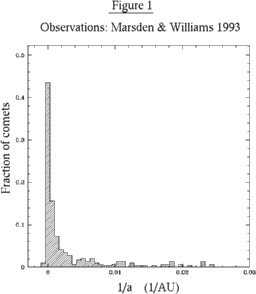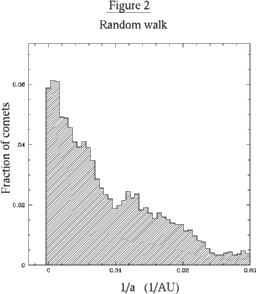 Figure 1: Observations (Click on image to zoom).
Figure 1: Observations (Click on image to zoom).
Ph.D. Thesis: The Evolution of Long-Period Comets
My Ph.D. research was focused on a number outstanding questions in cometary dynamics, in particular, the fading problem.
The afore-mentioned problem arises from a conflict between observations and theory. The observed distribution of orbital "original" energies (that is, the energies with which they approached the Solar System) of comets with periods exceeding 200 years (from Marsden & Williams 1993) is shown in Figure 1. (Note:the two-body energy of the comet is inversely proportional to the negative of the semi-major axis a). The narrow spike at small energies (i.e. large a) led Oort (1950) to advance the hypothesis that the Solar System is surrounded by a cloud of comet nuclei at large (r > 10 000 AU) distances. This theory has gained currency and the postulated ensemble of distant bodies is now termed the Oort cloud.
 Figure 1: Observations (Click on image to zoom).
Figure 1: Observations (Click on image to zoom).
Members of the Oort cloud are not visible in situ, but can only be observed when perturbations of their orbits by passing stars or the Galaxy's gravitational field reduce their perihelia to distances at which sublimation of their volatile components is possible i.e. r < 2-5 AU.
After having passed close enough to the Sun to become visible, the
comet's energy evolution is dominated by planetary perturbations.
Based on a model constructed for my Ph. D. research, and which
includes the effects of the dominant component of the tidal field of
the Galaxy and the four giant planets, a simple estimate for the
energy distribution of an evolved long-period (long-period indicating
comets with periods exceeding 200 years; long-period comets seems to
be dynamically distinct from those of shorter period) comet
distribution can be produced, and is shown below.
 Figure 2: Random walk. (Click on image to zoom).
Figure 2: Random walk. (Click on image to zoom).
If the computer model is correct then why the discrepancy between observations and theory? This problem is one of the longest-standing in the field of Solar System dynamics.
Many possible explanations for the fading problem have been put forward, but until now no one has completed a full-scale numerical integration of long-period comets throughout their lifetimes. Previous attempts to study this problem have been based largely on approximate simulation methods and analytic approximations, neither of which may be subtle enough to untangle all the dynamics involved
For my Ph.D. project, I performed a numerical integration of roughly 100,000 Oort cloud comets evolving within the Solar System. Once it became clear that a simple model in which the only dynamical influences on long-period comets were the giant planets and the Galactic tide, a wide-ranging examination of other possible dynamical mechanisms was performed. Such effects as radiation pressure, drag from the interstellar medium and the influence of the heliopause proved to be too small to have appreciable effects.
However, three dynamical effects seemed likely to have moderate to strong effects on long-period comet evolution, and were studied in some detail by means of the computer model. These effects include non-gravitational (i.e. outgassing) forces, and a hypothetical companion object or massive disk surrounding the Solar System. However, it was found that these effects were unable to resolve the fading problem.
Then, our attention turned to fading. Long-thought to be a possible explanation for the fading problem (even giving the problem its name), a rapid fading of comet's in brightness could account for the disparity, by removing comets from our observed sample, if not from the Solar System itself. As fading, if it exists, is likely to be extremely complicated, we investigated only a few simple one and two-parameter fading laws, in an attempt to roughly quantify the type of fading possible. In a nutshell, it appears that a resolution of the fading problem, even in conjunction with the effects of non-gravitational forces, would require very rapid fading over the first few apparitions and then very little. A model in which 95% of comets last only five apparitions and the remainder indefinitely reproduces observations well. Thus it seems that very fast fading indeed is required to resolve the fading problem. Unfortunately, to go further and determine the form of the fading law is likely to prove quite difficult, and will require more information on the physical characteristics of comet nuclei, as well as greater observational coverage of their orbits.
Marsden, B. G. & Williams, G. V., 1993, Catalogue of Cometary Orbits, IAU Central Bureau for Astronomical Telegrams, 8th edition.
Oort, J. H., 1950, Bull. Astron. Inst. Netherlands, XI(408):91-110.
If you have any questions regarding this project, please feel free to contact me at the e-mail address at the bottom of this page. The complete text of my PhD thesis is available for downloading.